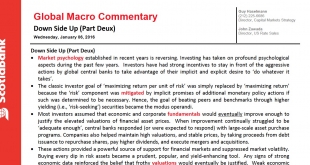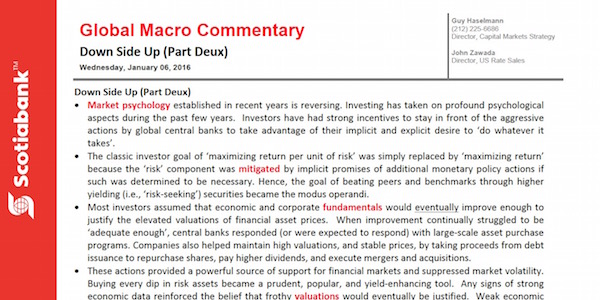Down Side Up (Part Deux)
by Guy Haselmann, Scotiabank GBM
 • Market psychology established in recent years is reversing. Investing has taken on profound psychological aspects during the past few years. Investors have had strong incentives to stay in front of the aggressive actions by global central banks to take advantage of their implicit and explicit desire to ‘do whatever it takes’.
• Market psychology established in recent years is reversing. Investing has taken on profound psychological aspects during the past few years. Investors have had strong incentives to stay in front of the aggressive actions by global central banks to take advantage of their implicit and explicit desire to ‘do whatever it takes’.
• Most investors assumed that economic and corporate fundamentals would eventually improve enough to justify the elevated valuations of financial asset prices. When improvement continually struggled to be ‘adequate enough’, central banks responded (or were expected to respond) with large-scale asset purchase programs. Companies also helped maintain high valuations, and stable prices, by taking proceeds from debt issuance to repurchase shares, pay higher dividends, and execute mergers and acquisitions.
• These actions provided a powerful source of support for financial markets and suppressed market volatility. Buying every dip in risk assets became a prudent, popular, and yield-enhancing tool. Any signs of strong economic data reinforced the belief that frothy valuations would eventually be justified. Weak economic data on the other hand was merely interpreted to mean that monetary accommodation would be maintained for longer or that more would be provided.
• There are many examples of weak economic data boosting financial markets due to this perception. (I first addressed this dynamic in my “Down Side Up” note of 5/7/15). This concept was visible on December 1st. ISM was forecast to rise from the prior 50.1 print, but it fell to 48.6 (the price component fell 4.5 points to 35.5) and the S&P rose 22 points (or 1.1%). In another example, payroll employment was forecast to post a 200K gain on October 2nd, but it rose only 142k and the S&P 500 rose 28 points (or 1.4%).
• In 2016, investors are likely to shift from ‘buying the dip’ to ‘selling the uptick’. The main catalyst is the fact that the Fed has started a hiking cycle. Some may prefer that I call it ‘the gradual removal of accommodation’. Regardless, the hurdle for the Fed to not hike again is high, and the hurdle to reverse back to an easing path is even higher.
• Although the BoJ and ECB continue to maintain their QE programs and the PBOC is offering various forms of support, the diverging direction of monetary policy means less support in aggregate for asset prices. In addition, the marginal benefit of monetary accommodation decreases over time. Could recent market behavior be warning that central bank support is unable to lift asset prices higher without stronger improvement in the fundamentals?
• In the meantime, US and global growth seems to be slipping. Chinese market and economic weakness, commodity price pressures, and a strong dollar are all thwarting the stabilization of important emerging economies. And, general uncertainties are intensifying due to escalating geo-political tensions, growing nationalism, and looming elections.
• The bottom line is that market volatility is rising and will remain pervasive for a while. The shifts outlined above in terms of market psychology, the change in direction of Fed policy, and the increases in general uncertainties, will all conspire to shape an environment ripe for sharp spikes in volatility. These spikes will be further amplified by rickety market liquidity. Banks and broker dealers have limited appetite and ability to expand their balance sheets, especially when markets need it most.
• On Monday, I detailed various reasons for finding Treasury securities attractive. The note outlines the attractive supply versus demand dynamics that make long-dated Treasuries technically attractive. Their deep liquidity and attractiveness relative to other sovereign yields also means that they could gain a bid as the factors discussed above play out.
• I am not afraid of being long 30 year Treasuries into Friday’s employment number. If the number is strong, then risk assets will be sold and the curve will flatten. If the number is weak, then risk assets will be sold aggressively, and the entire Treasury complex will improve.
“Education is what survives when what has been learned has been forgotten” – B. F. Skinner
Guy Haselmann | Capital Markets Strategy
▬▬▬▬▬▬▬▬▬▬▬▬▬▬▬▬▬▬▬▬▬▬▬▬▬▬▬
Scotiabank | Global Banking and Markets
250 Vesey Street | New York, NY 10281
T-212.225.6686 | C-917-325-5816
guy.haselmann@scotiabank.com
Copyright © Scotiabank GBM
Scotiabank is a business name used by The Bank of Nova Scotia














